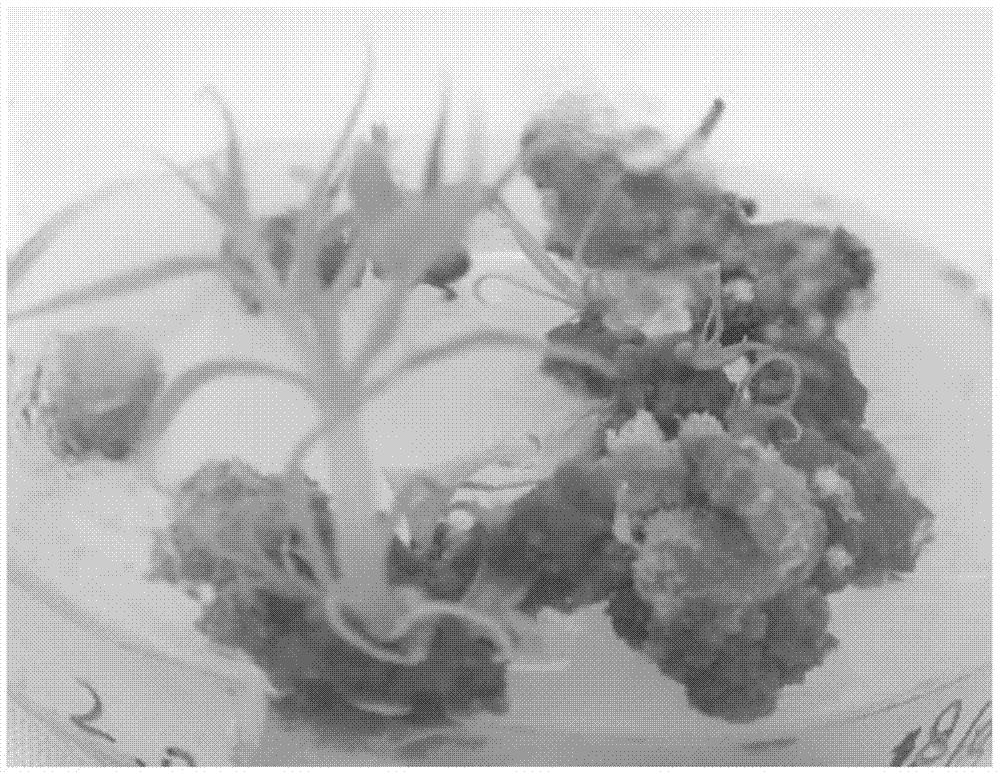The Method of Inducing Adventitious Buds from Petiole of Aseptic Tissue Cultured Lonicerae Lonicerae
A technology of honeysuckle and tissue culture seedlings, which is applied in the field of plant tissue culture, can solve the problems of low germination rate of sterile seedlings, high cost of seedling cultivation, and not many, and achieve long-lasting effects, long duration, and widening range effect
- Summary
- Abstract
- Description
- Claims
- Application Information
AI Technical Summary
Problems solved by technology
Method used
Image
Examples
Embodiment 1
[0027] A method for inducing adventitious buds from petioles of aseptic tissue cultured Lonicera red glandularis, comprising the following steps:
[0028] 1) Material preparation: Inoculate the aseptic tissue-cultured seedlings of Lonicera red glandularis into the rooting medium for cultivation, and obtain the aseptic tissue-cultured rooted plantlets with a seedling age of 45 days;
[0029] 2) Material sampling: take the normal petiole of the vigorously growing rooted seedlings of Lonicera red glandularis aseptic tissue culture with a seedling age of 45 days for use;
[0030] 3) Induction of petiole adventitious buds: the selected petioles to be used are treated to increase the surface area of the wound, and then inoculated in the adventitious bud induction medium for cultivation, and the petiole callus is induced, and the petiole is continued to be cultivated on the adventitious bud induction medium. Adventitious buds were induced from petiole callus, and the culture temper...
Embodiment 2
[0035] A method for inducing adventitious buds from petioles of aseptic tissue cultured Lonicera red glandularis, comprising the following steps:
[0036] 1) Material preparation: inoculate the aseptic tissue-cultured seedlings of Lonicera red glandularis into the rooting medium for cultivation, and obtain the aseptic tissue-cultured rooted plantlets whose seedling age is 50 days robust;
[0037]2) Material sampling: take the normal petiole of the vigorously growing rooted seedlings of Lonicera red glandularis aseptic tissue culture with a seedling age of 50 days for use;
[0038] 3) Induction of petiole adventitious buds: the petiole selected for use is treated to increase the surface area of the wound, and then inoculated in the adventitious bud induction medium for culture, and the petiole callus is induced, and the petiole callus is continued to induce adventitious buds , wherein the culture temperature of callus culture and adventitious bud induction culture are both 25...
Embodiment 3
[0043] A method for inducing adventitious buds from petioles of aseptic tissue cultured Lonicera red glandularis, comprising the following steps:
[0044] 1) Material preparation: inoculate the aseptic tissue-cultured seedlings of Lonicera red glandularis into the rooting medium for cultivation, and obtain the aseptic tissue-cultured rooted plantlets with a seedling age of 55 days;
[0045] 2) Material sampling: take the normal petiole of the vigorously growing rooted seedlings of Lonicera red glandularis aseptic tissue culture with a seedling age of 55 days for use;
[0046] 3) Induction of petiole adventitious buds: the petiole selected for use is treated to increase the surface area of the wound, and then inoculated in the adventitious bud induction medium for culture, and the petiole callus is induced, and the petiole callus is continued to induce adventitious buds , wherein the culture temperature of callus culture and adventitious bud induction culture is 28 ℃, the rel...
PUM
 Login to View More
Login to View More Abstract
Description
Claims
Application Information
 Login to View More
Login to View More - R&D
- Intellectual Property
- Life Sciences
- Materials
- Tech Scout
- Unparalleled Data Quality
- Higher Quality Content
- 60% Fewer Hallucinations
Browse by: Latest US Patents, China's latest patents, Technical Efficacy Thesaurus, Application Domain, Technology Topic, Popular Technical Reports.
© 2025 PatSnap. All rights reserved.Legal|Privacy policy|Modern Slavery Act Transparency Statement|Sitemap|About US| Contact US: help@patsnap.com


